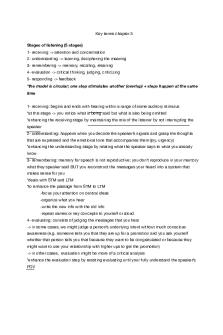Chapter 1 - Key Terms - Professor McBride PDF

| Title | Chapter 1 - Key Terms - Professor McBride |
|---|---|
| Course | Integrated Business Experience |
| Institution | Central Michigan University |
| Pages | 2 |
| File Size | 69.4 KB |
| File Type | |
| Total Downloads | 29 |
| Total Views | 158 |
Summary
Professor McBride...
Description
Answer Sheet Chapter 1 - Business Processes/Evolution of ERP’s Define each of the key terms listed below. These terms can be located in the reading material. Upload the completed document to Blackboard. 1. Business process integration: Synchronizes a company's internal operations by connecting various technical systems in real-time. It must be a process or a group of people with different functional expertise working toward a common goal. 2. Business process(es): A collection of linked tasks which are completed in the delivery of a service or product to a customer. 3. Data: Facts and statistics collected together for reference or analysis. 4. Data integrity: The accuracy and consistency (validity) of data over its lifecycle. 5. Database: Structured data in tables organized in a specific manner. 6. Effective: Illustrates how well a process achieved the organizational goals with which it is aligned. 7. Efficient: How well we are executing our standard process from the standpoint of time, quality and resources being consumed. 8. ERP: Provides an organization with the ability to integrate most, if not all, the functional areas of an organization . 9. Functional silos: The gathering of data to fulfill a need for a single area of your business which disregards the transparency between departments. 10. Information: Data that is organized within a context of a question; Something that can be used to increase knowledge. 11. Information system: Any organized system for the collection, organization, storage, and communication of information 12. Integration: The act or effort of bringing more than one thing together to act as a whole. 13. Latency: The delay before a transfer of data begins following an instruction for its transfer. (Where nothing happens, and time is consumed). 14. Master data: Data repeatedly used in a system and is used to create a transaction. 15. Non-value activity: Generates a zero or negative return on the investment of resources. They usually can be eliminated without impairing a process 16. Organizational data : Represents the legal and regulatory reporting structure of an organization. a. The organizational data is from the information systems point of view and reporting here refers to the generation of reports to publish financial statements or make decisions
17. Shared services: Functions that are used throughout the organization by all functions. Supports the core processes and leverages a standard way of doing work across the business. 18. Transactional data: The history of what has been done meaning what we’ve made, bought and sold, who did it, and for how much.
a. Transactional data uses organizational data along with master data and adds specific process detail such as quantity, current date, the employee entering the data, and other time-specific data to form a complete historical record of the transaction. 19. Value added activity: a. Step transforms the item toward completion b. Step is done right the first time (not a rework step)
c. The customer cares (or would pay) for the step to be done...
Similar Free PDFs

Chapter 3 key terms
- 2 Pages

Chapter 14 Key Terms
- 2 Pages

Chapter 3 Key Terms
- 3 Pages

Chapter 4 key terms
- 2 Pages

2-1 Key Terms
- 2 Pages

Key terms chapter 3 pdf
- 5 Pages

Key terms chapter 6 pdf
- 8 Pages

Key Terms
- 3 Pages

Microsoft key terms 1 - iii
- 5 Pages

KEY Terms - Lecture notes 1
- 4 Pages

Chapter 1 Medical Terms
- 2 Pages

Chapter 1 terms
- 3 Pages
Popular Institutions
- Tinajero National High School - Annex
- Politeknik Caltex Riau
- Yokohama City University
- SGT University
- University of Al-Qadisiyah
- Divine Word College of Vigan
- Techniek College Rotterdam
- Universidade de Santiago
- Universiti Teknologi MARA Cawangan Johor Kampus Pasir Gudang
- Poltekkes Kemenkes Yogyakarta
- Baguio City National High School
- Colegio san marcos
- preparatoria uno
- Centro de Bachillerato Tecnológico Industrial y de Servicios No. 107
- Dalian Maritime University
- Quang Trung Secondary School
- Colegio Tecnológico en Informática
- Corporación Regional de Educación Superior
- Grupo CEDVA
- Dar Al Uloom University
- Centro de Estudios Preuniversitarios de la Universidad Nacional de Ingeniería
- 上智大学
- Aakash International School, Nuna Majara
- San Felipe Neri Catholic School
- Kang Chiao International School - New Taipei City
- Misamis Occidental National High School
- Institución Educativa Escuela Normal Juan Ladrilleros
- Kolehiyo ng Pantukan
- Batanes State College
- Instituto Continental
- Sekolah Menengah Kejuruan Kesehatan Kaltara (Tarakan)
- Colegio de La Inmaculada Concepcion - Cebu



